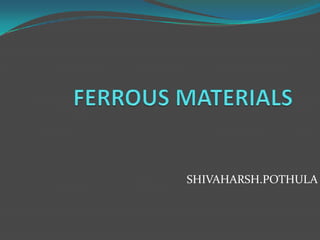
Brief study of ferrous materials
- 2. Ferrous materials have base metal has iron Ferrous materials can be classified as Pig iron Wrought iron Plain carbon steel Alloy steels Cast iron
- 3. a) PIG IRON Composition: carbon -3.5 to 4% silicon -1 to 3 % manganese -.1 to 1 % phosphorus -.2 to 1.5 % sulphur - <.5 % iron - remaining Uses: raw material for the production of wrought iron, steel and cast iron
- 4. b) Wrought iron Produced from pig iron either by puddling process or by byers process Contains .12 t .15 % of carbon It contains high ductility and it can be easily forged and welded It is used for making small pipes and fittings corrugated sheets and also used for making chains, bolts ,nails ,anchors etc
- 5. c) PLAIN CARBON STEELS (PCS) Steel is an alloy of Fe+C + small quantities of (Si+Mn+P+S) It mainly depends on amount of carbon content Plain carbon steels Low carbon steels - .08-.3% Medium carbon steels- .3-.6 % high carbon steels - >.6 % (-1.5%) % by carbon
- 6. low carbon steels (PCS) Carbon content .08-.3% Mechanical properties – high ductility, good machinability and weld ability ultimate tensile strength- 4000-6000kg/cm2 brinnell hardness number- 150 Not affected by heat treatment Uses : wires, riverts, screws, bolts, nuts, sheets, plates, tubes, rods and for general work shop
- 7. ii) Medium carbon steels (PCS) Carbon content-.3 to .6% Mechanical ppts are improved by heat treatment process Mechanical ppts –less ductility and machinability than mild steels, easily forgeable and weld able ultimate tensile stress- 7500kg/cm2 brinnell hardness number-200 Uses : making nuts bolts , springs, agricultural tools. Large forging dies
- 8. iii) High carbon steels (PCS) Carbon content: .6- ~1.5% Mechanical ppts are further improved by heat treatment process Mechanical ppts – high strength and hardness ,low ductility and malleability ppts for ~.8% carbon content ultimate tensile strength-9500-11000kg/cm2 brinnell hardness no. – 550 Uses : makings making springs, metal cutting tools, press work dies and punches, forging dies, hand files etc.
- 9. d) ALLOY STEELS (AS) Other than Fe & C other metals are used to attain the better ppts Uses of alloying elements to steels To increase harden ability To improve mechanical ppts To increase corrosion and wear resistance To improve magnetic ppts Alloying metals are Al, B, Cr, Co, Mn, Mo, Ni, P, Si, S, Ta, Titanium, Tungsten, vanadium
- 10. Influence of alloying elements (AS) Al : deoxidizer, restricts grain growth. In small quantities increases strength but too much gives embrittlement, 2-5% imparts resistance to heat and oxidation B : hardening agent and expensive only little amount as .003% is used too much creates embrittlement and hot shortness Cr : forms hard carbides. Imparts ppts like strength impact strength, wear and corrosion resistance when added in small qty it decreases machinabillity and decreases hardening temp. when unbalanced with Ni
- 11. Co: red hardness by retaining high carbides on heating. it can decarburize during heat treatment. Increases strength ,residual magnetism ,hardness when added in small qty. high qty decreases impact strength Cu: (~.1 to ~.4)% increases resistance to atmospheric corrosion and strengthing agent Mn: least expensive ,used for deoxidation and desulphurization of molten steel. Added as ferromanganese and spiegeleisen. Mn present( ~.4 to ~1)%.it increases tensile strength and hardness. If added in large qty lower critical temperature and material quenched rapidly. It becomes austhentic and posses toughness wiith ductility
- 12. Mo: it is the counter metal for the Ni+Cr to reduce the brittleness. It reacts with Fe and forms double carbides. It increases high temperature strength and impact strength at high temperature. It increases the machinability of carbon steels P: P is always present in varying amounts in steels. It separates as iron phospide which is hard and brittle. Therefore more addition increases brittleness. At~.05% itt increases the tensile strength and hardness, machinability . And resistance towards corrosion Si: It is generally present in varying qty which is added ~0.05% which increases the machinability and also increases the magnetic nature of the metal . Generally this metal increases the conducting nature. It is deoxidozer and degraphitizer
- 13. S: it is the harmful element present ~0.05%. It induces heat shortness in steel Ta: it is generally added to improve scaling at high temperatures Ti: It is a strong carbide forming substance. It inhibits the grain growing on the metal. It inhibits corrosion of Cr carbides W: It is a strong carbide forming substance. It stands for strong wear and abrasive resistance. It retards the softening of martensite during tempering therefore it gives red hardness.
- 14. V: it is a powerful deoxidizer a strong carbide former, inhibits grain growth and very expensive. It has excellent wear resistance if it added to~0.05% These alloy elements are developed depending on there use and respective property natures
- 15. SPECIAL PURPOSE STEELS these are generally formed to satisfy the peculiar needs. They are generally classified in to following types High speed tool steel High chromium steel Stainless steel High Ni steels and Ni alloys Austenitic steels and alloys Heat resistance steels
- 16. USES : These materials has various uses depending upon the situation The materials take the advantage of the composite materials
